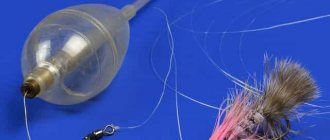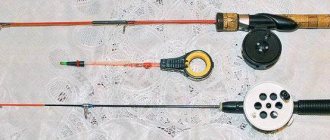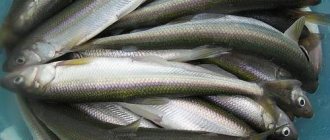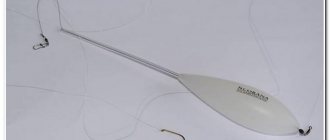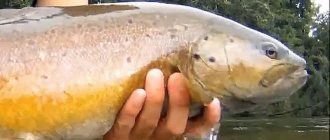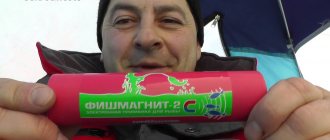No self-respecting fisherman will miss the opportunity to get acquainted and further practical use of this interesting method of equipment. Such a tempting and mysterious abbreviation attracts the fisherman with its sound and inspires him with hope for solid catches, which, by the way, are not empty words that have a real basis.
Of course, not everyone who tries the equipment in action later becomes its ardent fan. But everyone will agree that a bombard for fishing is a spectacular and effective element. And this is not a tribute to fashion, but a modern approach, where there is a reason to use productive and progressive equipment.
What is a bombard?
Fishing with a bombard is a type of equipment that allows you to catch a variety of fish, the main element of which is a float in the form of a miniature egg, strung along its axis on a small diameter tube. The main role of this float is to ensure the casting range of small bait, as well as control the level of depth of the thrown bait during the process of retrieving it.
For general development and to exclude double assessments, I can say with confidence that the name of the bombard float, which has become more familiar to us, is quite identical to the word sbirulino. Therefore, there is no need to look for differences in equipment, since it is absolutely the same equipment. This float is made of dense plastic and its colors can vary from transparent specimens to options with exotic colors, for example, acidic or black with a metallic tint.
Methods of fishing with a bombard
The use of a bombard may involve various methods of catching trophies. Among the frequently used ones are:
- slow - most often used for shallow water and implies a smooth casting of the bait;
- fishing using jerks - after throwing the bait, you need to make sharp jerks with the tip of the rod to attract large trophies;
- twitching the bait. Smooth twitching of the bait can be carried out. The frequency and intensity are selected individually by each fisherman during the fishing process.
Good to know! Fishing experts say that the best method is to combine several fishing methods.
Benefits of fishing
When fishing with a bombard, the following advantages should be highlighted:
- The float is quick to install and can be used even by beginners in fishing.
- Can be used to catch any type of fish.
- Any type of bait can be thrown over a long distance.
- You can fish using fly fishing flies.
- The bombard, which slowly sinks to the bottom, attracts predatory fish.
Note! Also, one of the most compelling positive reasons to use this type of product as a bombard is the ability to catch large trophies at various depths without the use of motorized equipment.
What are the types
If there is no need to talk much about the shape of the float, since in this equipment it is uniform and varies only in the size of its ratio, then there are significant differences in the floating properties and loads on which, in essence, the methods of fishing with a bombard are based.

So: according to buoyancy, floats are divided into floating - intended for fishing on the surface of the water, slowly sinking - this type allows you to fish at a certain depth level, and quickly sinking - with which you can quickly deepen a tiny-sized bait and hold it at the very bottom.
The design of the loading float may also differ. There are two main types of loading sbirulino. The first method is a stationary loading, so to speak, a factory setting that cannot be changed. The second type of float is with an empty chamber, which by filling it with water, you can achieve the load required for the fishing conditions. As can be seen from the above-described nuances in the structure of this device, you can have quite wide possibilities for using equipment for bombard fishing in a variety of fishing conditions. Well, the more opportunities a fisherman has, the more successful and higher the catches, which is a sin not to take advantage of.
Bombard classification
Modern bombards have a huge range and variety, which can be distinguished by their structure and purpose in certain fishing conditions.
Bombard floats, or as they are also called, sbiruline floats, have different weights and buoyancy. It is customary to distinguish them by these features.
The buoyancy of a bombard is as follows:
- Floating bombards in water that do not sink at all.
- Sinking bombards , which when they hit the water, immediately sink to the bottom of the reservoir.
- Slowly sinking floats. They can be held in the layers of water needed by the fisherman.
Having a floating bombard, you can move baits directly through the upper layers of the water, which can be very effective. If you want to catch fish that usually live on the bottom, then it would be wiser to use sinking bombards.
In addition, these floats have different types of loading:
- A bombard with a built-in weight , which is usually made of lead.
- A bombard with an internal void that fills with water. The main advantage of using such floats is that fishermen can independently control the load.
Rod selection
As with any other common type of fishing, there is specialized equipment for their conditions. In nature, fishing gear also includes a bombard rod. Manufacturers of gear endow it with certain qualities that provide comfort and reliability when fishing with a bombard. In general, such a rod can be described as a soft rod of parabolic action, measuring from three to six meters with a test in the range of 25–60 grams.
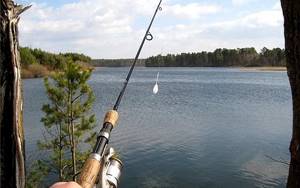
But these characteristics of the gear do not mean that its other technical potential cannot be used with a float. A spinning rod for a slow action bombard is an ideal example of this. The telescopic rods of the above test frames can also serve as an excellent example. Match gear adapted for sbirulino also sufficiently provides the possibilities for this fishing method.
Bombard equipment
Bombard fishing tackle has its own classic rigging algorithm, which varies by replacing the floats, the length of the leashes and the type of bait. The classic is to equip the tackle with a medium-sized spinning reel with a friction gear designed for spinning fishing for predatory fish. The reel is equipped with monofilament or braided cord, depending on who you like, because this factor will not have a decisive significance on the quality of fishing with a slow rod action, with a thickness of 0.2 to 0.3 mm and a volume of at least one hundred meters. A bombard is strung on a cord. Its movement up the line is limited by a stopper. A meter and a half, or even a meter, is quite a sufficient distance.
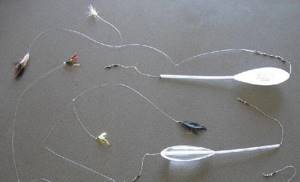
Next, a block of swivels is tied to the fishing line; three or five in a row completely satisfy the conditions that prevent the main thread from twisting. It is mandatory to place a damper bead made of strong material in front of the knot. The float, with each cast, will necessarily and with considerable effort repulse its inertial mass from it. At the end of the swivel block, the installation ends with a clasp to which leashes with baits will be attached.
Important! Various types of baits can serve as bait, ranging from animals to a variety of artificial ones.
Depending on the type of fish, worms, maggots, pearl barley, mastyrka are used, and, of course, wobblers, spinners of various designs, and artificial flies are an integral part of this bombard fishing subculture.
Fishing with a bombard fly involves the use of floating floats. Chub, rudd and saberfish become the main objects of hunting with such equipment. Bombard fishing for asp, perch, trout, bream and pike requires the use of slowly sinking floats. Fast-sinking representatives of the bombarda are used for catching bottom fish, such as catfish and, to a greater extent, pike perch.
Important! The length of the leash depends on the timidity and caution of the fish.
Pike are not afraid of the float and even make attacks when it moves, so when catching it, a thin metal leash of 30 cm will be enough. Often, focusing purely on pike fishing, anglers additionally equip the bombard itself with a suspended tee, and not without success. Wary and suspicious trout need leashes of one and a half meters, which is why six-meter rods are not uncommon in bombard fishing, because it is in principle impossible to cast such long rigs with a shorter rod.
Bombard equipment - DIY installation and fishing techniques
A bombard is a water-filled float with a plastic tube through which the main fishing line is threaded. In the lower part, such a device has a special thickening, usually in the shape of a drop, which gives the bombard additional weight or buoyancy. Essentially, bombarda, or sbirulino, is a float. The main task of which is to provide the angler with the opportunity to cast even very small baits over very long distances.
How to make tackle with sbirulino? For these purposes you will need:
- fishing line;
- swivels;
- stoppers;
- hooks;
- float;
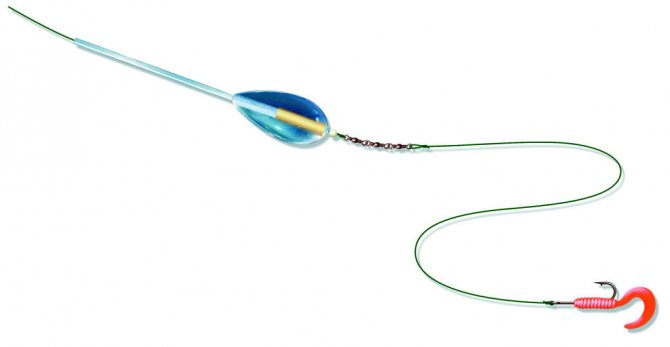
Step-by-step instructions for knitting a bombard
First, a float is attached to the main line, the movement of which along the line is limited by two stoppers - below and above. This is done in order to actually fix the float and prevent it from hitting the place where the swivel is attached when casting.
After the float, a swivel is attached, sometimes it is mounted alone, and sometimes a whole series of three swivels is attached. A leash with a length of 1.5 to 3 m is mounted next to the swivels.
The bait you are going to fish with is attached to the end of the leashes. To begin with, it is better to equip the bombard with only one hook. Because it’s better to get used to the gear and become familiar with the intricacies of handling it, and only after that you can begin to gradually increase the number of hooks on the main line.
A wide variety of bombards are currently produced. In order to choose from the huge assortment of bobbers offered by the real market, you need to remember that the choice of sbirulino is mainly determined by the type of fish that is being quietly hunted, as well as the body of water on which you are fishing. For medium-sized rivers, floats weighing 10-20 g are better suited. For standing reservoirs, it is better to use bombards weighing 15-30 g.
Lures
When fishing with a bombard, an angler can use a variety of types of bait.
An angler can attach a wide variety of natural baits to a hook:
However, artificial types of bait can also be used. On riffles and near small holes, with a sharp pull, the artificial fly sinks well into the water. This type of bait has proven itself well when fishing for grayling. Therefore, if you often catch it, you can use a tackle with sbirulino and a fly. But the arsenal of baits that can be used when fishing with a bombard is not limited to flies.
Anglers successfully catch predators, as well as fish that can be considered predatory using small spoons, jig baits and even small wobblers .
You can fish with sbirulina tackle:
In fact, an angler using sbirulino has access to all types of baits from the arsenal of a float fisherman, a spinning fisherman, and even a fly fisherman.
How to choose a place when fishing with a bombard
Most often, predatory and conditionally predatory fish are caught on sbirulino. Therefore, choose places that are typical for predators. Quiet backwaters with a slow reverse current are good for these purposes.
Look for changes in depth and typical predator sites – dumps. It should be noted that in summer, when almost the entire surface of reservoirs is covered with aquatic vegetation, it is very difficult to choose a place for fishing with bombard. Here, non-hooking spinners will come to your aid; the floats themselves, thanks to their streamlined shape, easily pass through thickets of vegetation.
In small bodies of water, the predator can stand anywhere among the grass, snags and mud. Therefore, it is very difficult to choose a fishing spot on such rivers. You can only try to systematically fish the entire river bed section by section.
Features by fish species
Chekhon
In the summer, when the sabrefish are fattening, you really want to catch it with a spinning rod, but it practically ignores ordinary spoons. This is where the bombard will come to your aid.
The bait (it is better to use a worm) is thrown directly into the cauldron of fattening fish. When fishing this way, the retrieve is slow, with short pulls. The result should pleasantly surprise you: in 10 minutes of fishing you can catch half a kilogram of sabrefish.
The best baits for catching sabrefish using a bombard include:
- maggot;
- dung worm;
- white twisters;
- pearl barley and mastyrka;
During long casts, the pearl barley can fly off the hook, so it is safer to use a mast for these purposes. In addition, it is worth noting that plant baits are still less effective than animal baits when catching saberfish.
Asp
The best time to catch asp is summer. In summer, this type of fish bites best at dawn and in the evening, when the heat subsides.
You can also catch asp in the spring. At this time of year, you should look for it in holes, at depth.
In autumn, the peak of asp activity occurs in the afternoon. It is very difficult to catch in the fall, but if you do catch one, chances are it will be a sizeable specimen.
The method of catching an asp with a bombard is quite simple: throw the tackle behind the cauldron of the fattening predator or to the side of it. As a rule, the bite occurs in the intervals between stretches.
Chub
It is possible to catch bombard and chub using the tackle. The gear has the following structure:
- a rod, 2.5-3 m long when fishing in open areas and up to 2.5 meters when fishing on a small river;
- spinning reel, size 2000, main braided line, 0.12 mm thick,
- leash line, diameter 0.15-0.18 mm, fluorocarbon
- hooks No. 8-12.
You can catch chub using both artificial and natural bait. When fishing with a cockchafer, for example, you must remember that the chub is a cautious fish, so the leash must be at least a meter in length.
When you are fishing for a cockchafer using gear with sbirulina, remember that if the line is very tight or moves sharply to the side, this means a bite. At this moment, there is no need to waste time - make a good hook in order to properly hook the biting fish.
If you fish with artificial baits : wobblers or spinners, then keep in mind that the main, most catchy types of fishing in this case are twitching and various types of uniform fishing.
Our rating of the best wobblers for catching chub with a bombard includes:
- Yo Zuri Quiet Wave Flat;
- L Minnow 44;
- Smith Camion SR;
- Griffon Zero;
- Tsuribito Baby Crank 35 SR;
With the beginning of the flight of insects at the junction of summer and spring, the ide feast begins. During this period of time he is more active than ever. At this time, it is better to catch ide with a bombard.
This equipment is so effective when fishing for ide that if you don’t catch an ide with it, it will mean that there is simply no ide in this body of water, or it is not very active.
The best bait for catching ide is considered to be a grasshopper; you can also use gadflies and various types of flies, the flight of which coincides in time with the ide’s feeding. In addition to natural baits, you can also use artificial baits, preferably flies.
Do not forget also that you need to look for ide where a slow current intersects with a fast one, trees hanging over the water, windows in aquatic vegetation, in short, places where a predator can hide for an ambush.
Bleak
Bombarda is a fairly versatile tackle. Therefore, you should not be surprised that you can also catch small fish, such as bleak, with it.
This fish needs to be fed. Use an inexpensive slingshot to send clumps of bait away from the shore to attract large bleak and other critters. The bait should be floating on the surface.
It has been noticed that on sunny days or days of cold weather the bleak sinks closer to the bottom. But it is worth remembering that usually this type of fish stays at a depth of up to 1 m from the surface.
Now a little about baits. The best natural bait is maggot. Bleak readily pecks at it throughout the daylight hours. Among the artificial ones, it is necessary to highlight nanotwisters, small flies and edible plastic, as well as small nymphs . Moreover, the equipment must be mounted in such a way that the nozzle rotates as much as possible during wiring. Standard wiring when catching bleak on a bombard is no different from the usual one, which can roughly be called: “throw it in and pull it.”
It would also be useful to use various attractants. When the bait is treated with a flavoring agent, the fish bite more confidently and more often. Use garlic juice, for example.
Perch
When the time comes when the fish are reluctant to take the bait, and the time for fishing is limited to 2-3 hours, the best way out of the situation is to catch perch with a bombard.
Perch bites readily in the fall. The best time is early in the morning at dawn and shortly before sunset and until darkness. At night the perch does not bite.
Twisters, small spoons and vibrotails can be used as bait. As you can see, these are all imitations of sick fish, so small fish can also be used as bait. As for natural baits, I would like to highlight the worm among them.
Another interesting equipment for fishing from the bottom, and not at the surface, is a drop shot. It will help target a slightly different group of aquatic inhabitants.
A single leader is a very similar version of a bottom rig to a bombard.
As mentioned above, the bombard is a fairly universal tackle. You can fish with bombard and pike. In this case, a prerequisite is the presence of a metal leash. As for the length of the leash, it should be noted that in the original it can reach a length of up to 1.5 m, no more. However, if you fish in vegetation, then you can limit yourself to a length of 50-70 cm: pike is not a shy fish, and handling such a leash will be much more convenient.
The best bait when fishing for pike with a bombard are:
- minnow-shaped wobblers;
- poppers (surface squelching wobblers);
How to fish with a bombard
The range and accuracy of delivery of small baits allows you to fish large areas of water by casting the equipment from one point.
Important! Having identified a promising place, you need to throw it and pause to allow the bait to reach the desired depth level. When the float brought to the required horizon is stabilized, wiring begins.
Postings with bait stops, like jigs, twitching movements with a rod, tossing of equipment, ordinary wiring by winding the cord - everything is acceptable when using bombard fishing tackle. Improvisations with pauses irritate perch, pike and pike perch. The monotony of the wiring tempts rudd, bream and catfish to bite.
Hanging the bait in the water column perfectly attracts the picky and seemingly completely elusive asp to bite. Stepped wiring is the king of techniques when hunting for trout representatives of reservoirs. Fly fishing with a bombard is similar to the fly fishing technique. Having mastered this direction, your catches will include chub, grayling and saberfish as regular trophies.
Fishing technique
Sbirulino opens up wide possibilities for fishermen in fishing techniques. Thanks to the heavy float, making long casts with light bait is not difficult. But how to do the wiring has to be decided right on the pond.
The technique of fishing with a bombard depends on the type of fish for which the angler came:
- For example, insects or their imitations are used to catch a chub or asp on a river. The equipment is thrown into a promising location, and then alloy wiring is done. The bait floats realistically with the current, tempting the fish to bite.
- If you want to catch sabrefish or rudd, which feed in the middle layers of water, then choose a slowly sinking float and a wet fly. After casting the rig, a pause is made to allow the bait to sink to the desired depth. Wiring is performed by slow, uniform rotation of the coil. The tackle can be equipped with several hooks, then you can catch several fish in one trip.
- When hunting for pike perch, you need to deliver the bait to deep areas of the reservoir. The easiest way to do this is with a fast-sinking bombard. You can choose live bait or artificial fish as bait. While retrieving, you should pause and twitch the rod tip. It is important that the bait is always in the bottom horizon.
Fishing with sbirulino allows fishermen to take a creative approach to their favorite pastime.
This tackle forgives even mistakes that may occur during the process.
You just need to decide on the type of fish for fishing, and then assemble gear suitable for the conditions of the reservoir, especially a bombard float. Then a good bite and pleasure from active recreation will be guaranteed.
Advantages of gear
The main advantages of fishing with this method include, as has already been mentioned more than once in the article, the possibility of delivering small and light bait to a considerable distance from the casting point. By varying the mass of the float in combination with baits of various types, delivering the equipment to the hundred-meter mark is a realistically achievable goal.
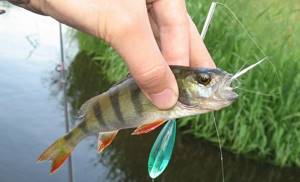
The advantages of such a cast are obvious; cautious fish that ignore the proximity of the shore can actually be provoked to bite. An important advantage of this type of equipment is the possibility of finer control of the level of the horizon of the bait in the water column. With other fishing methods, in particular spinning, such fishing can only be carried out by a fairly experienced angler.
When fishing with a bombard, having selected the desired type of float, including the standard size and weight, almost any angler will perform such manipulations at the required fishing horizon. This method also solves the problem of delivering small baits to depths that are prohibitive for them. For example, a suspended wobbler of three or five grams, a sinking float with a short leash, can actually press it to the bottom of the reservoir, causing a bottom predator to bite.
A do-it-yourself bombard is not an advantage if a fisherman can make such a device from improvised and cheap materials. But more specifically about this, in the chapter below.
Sbirulino
Sbirulino floats come in a variety of sizes and weights, but it is best to buy floats whose weight will fluctuate around forty grams.
Types and types
By type, these floats are:
- floating;
- slowly sinking;
- sinking quickly.
They are used for catching fish at different water levels in reservoirs. For example, trout fish are usually found on the surface of the water, so floating bombards should be used to catch them, and pike perch most often live on the bottom, so it would be wise to use a fast-sinking float to catch them.
Based on the position of the built-in weight in bombards, the following varieties are distinguished:
- Classiche. This is a float that is considered a classic. The weight in it is located in the lower region of the “body” of the tackle. Due to this arrangement of the weight, this bombard enters the water along a vertical line;
- Moretto. The weight in this float is located throughout its “body”. It is used for fishing in mid-water levels or on the bottom. Due to the fact that the weight of the weight is evenly distributed along the entire length of the float, it always enters the water very smoothly and behaves smoothly when moving;
- Competition The weight in this float is located in its very center, so the bombard has a parallel position in relation to the fishing line during retrieving and entering the water, which makes it very sensitive to bite. In addition, by moving the fishing rod and retrieving movements, you can add additional speed to the bait, causing the bombard to oscillate near it;
- Match. The weight in these floats has an elongated shape and is located in the upper zone of the float. When wiring, their position is very close horizontally. Such a bombard is usually immersed in water with its upper part and immediately sinks to the bottom;
- Magic . The weight is located in different parts of the float - upper and lower. This is the most sensitive bombard. When entering the water, it has a horizontal position.
Leash
The length and material of the leash are selected depending on the desired catch. Despite this, there is a classic version of the leash, which is made from a fluorocarbonate piece of fishing line with a diameter of 0.20 mm and a length of 1.5 meters.
Swivel
Swivels are used to equip bombards so that the fishing line that holds them does not get tangled or twisted, since spinners often tangle it. It is best to use a triple swivel for a bombard, the size of which will be from fifteen to twenty.
Hooks
Hooks should be as strong as possible and have very sharp tips. If the catch will be made with live bait, then the hook should have a long shank and a small “beard”.

The size of hooks should be selected depending on what kind of fish will be caught and what its average size is.
Step-by-step instructions for tying rigs:
- Attach a float to the main line, which should be slightly limited in its movements along the line. To do this, it must be equipped with two stoppers, which are fixed at the top and bottom of the float. This is necessary so that the float does not hit the swivel when casting.
- Attach the swivel to the fishing line.
- After the windlug, you need to mount a leash, which should be from one and a half to three meters long. At the very tip of the leash you should attach a bait that was prepared in advance.
- When using a bombard for the first time, it is advisable to use only one hook. This is necessary so that the fisherman can test the gear in action and understand not only the general technique of such fishing, but also all the little details. After this, you can safely use two or three hooks.
The choice of modern bombards should be made based not only on the type of fish, but also on the bottom of the reservoir in which the fishing will take place, its topography, the degree of softness or hardness and the type of current.
For example, sbirulino, whose weight will be about ten grams, is better used in reservoirs with a large current, and sbirulino with a weight of thirty grams will be convenient for fishing in water with a quiet current.
How to make a bombard
There is nothing complicated in the options; you can make this wonderful float yourself. A homemade bombard, with proper balancing of the main body of the float on the rod, will not differ in any way from the qualities of its factory counterpart. As the main body of the float, you can use foam blanks, polished to the desired shape and with weights mounted inside.
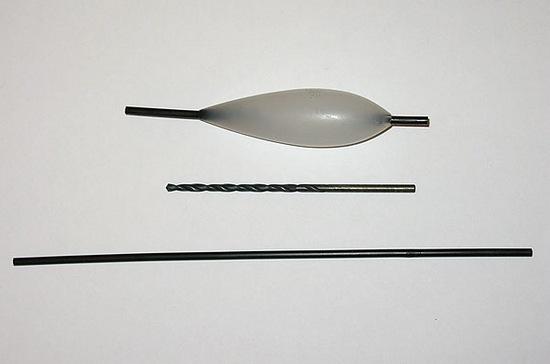
Old floats with broken antennas for float fishing are also do-it-yourself bombards. By drilling a hole and placing the body of the future bombard on a hollow rod that has a certain mass balanced with the float, you will get a floating representative of the equipment. But the proposal from a disposable syringe claims to be a really accurate version of a bombard for loading at the fishing site. Having shown imagination and a little effort, and subsequently received results in the form of successful bites, the fisherman who has made this modern attribute of equipment can rightfully be proud of his resourcefulness and skills.
